“I drive up once a week and brush the horses,” she said.
“That sounds great,” I replied.
At that time I was riding at Windy Ridge Stable and taking English/Hunt lessons with Veda Tupy the coach for the Binghamton Equestrian Team. Horses have a way of getting into your blood and helping out at a rescue facility sounded pretty good to me. I called Pam Watros, the director and founder of Meadowgate, an eighty acre horse rescue facility.
“Many of our rescued horses have been abused. They are not like other horses you may have dealt with.” said Pam.
“I can understand that,” I said.
Do you have experience with horses?” asked Pam.
“I had a horse when I was young and I currently ride at a local stable,” I replied.
“Well, can you come help me feed the horses at 8:00 AM on Saturdays?” she asked.
I hesitated for a moment. The idea of getting up early and driving 40 minutes on Saturday morning wasn’t exactly my first pick for time and day to volunteer. However, I really wanted to help out and if that was the only slot open then I’d do it.
“I’ll be there Saturday at 8:00,” I said and hung up the phone.”
My alarm jolted me awake and I jumped out of bed, threw on my clothes and headed up route 34 towards Meadowgate. I met Pam and we started to work. First we collected the empty grain pails from the pastures, returned to the barn, filled the grain buckets and piled hay into the back of the Utility Terrain Vehicle.
“Before the UTV, I loaded hay in a wheelbarrow and pushed it up the hill through the ruts in the road to the pastures.” Pam said. “This is so much easier.”
“I can’t believe you did this with a wheelbarrow,” I replied quickening my pace to keep up with Pam.
“You do what you have to do with whatever you have,” Pam replied.
We hopped into the cab; Pam put her foot on the gas and headed the vehicle up a steep hill toward the pastures. At the top of the hill we bent low and crawled under the electric fence lugging the grain pails. The buckets were left for the horses waiting in the pasture to be fed. We walked to the back of the UTV, gathered an armful of hay and threw it into the pasture.
“How did you get involved with rescuing horses?” I asked getting back into the UTV. Pam turned the key in the ignition and we headed towards another pasture.
“I was looking at a Quarter Horse for my daughter Jaimi at Carol Cook’s stable. Carol rescues Thoroughbreds. She told me some stories about the horses she’s helped and how she started,” Pam replied. “Ordinary horses in our area didn’t have a rescue facility so I felt there was a need that wasn’t being met,” said Pam.
The work feeding the horses was finished. Pam pulled the UTV into the barn. We walked towards the tack room where the western saddles hung in a long row against the wall. I picked up my jacket from a hook near the bulletin board.
“Rescuing horses seems like a massive undertaking,” I said putting on my jacket.
“I started the process in 2004 to establish a non-profit 501(C) organization. First I researched if a horse rescue was needed in our area. I sent out letters to vets, law enforcement agencies and farriers,” Pam said walking towards the huge sliding barn doors.
“Did they actually respond to you,” I asked.
“I didn’t get much response except from law enforcement. Their answer was yes but they didn’t offer any help in setting up an equine rescue facility. I hired a lawyer to setup Meadowgate. At first we were an umbrella organization of the Community Foundation of Thompkins County. Now we are an independent non-profit,” Pam said smiling. She pulled the massive barn doors open so we could step outside.
“Where did you gain the knowledge to manage such a large barn?” I asked as we walked down the gravel driveway towards our vehicles.
“When I was 19 years old I got a job at the front desk of Laquinta Motor Inns in Atlanta Georgia. One of the project supervisors had a farm in Texas. We started talking about horses and he told me about a woman in Texas who had a farm with 50 horses. I contacted Alice at Dreamland Acres Farm and went to work for her. She had Hanoverians, Arabs, Welch Ponies, and Welaras which are a cross between an Arab and Welch Pony. I became her barn manager and gained a great deal of experience in farm management overseeing the care of her horses,” said Pam.
“Are you still in contact with Alice,” I asked.
“I keep in touch with her daughter,” Pam said. “Alice died of cancer several years ago.”
We fed the horses Saturday mornings throughout the fall, winter and into spring. It took us about an hour to complete the morning feeding. When the cold winter weather started to turn balmy and spring came we stayed and worked with the horses. Sometimes Hannah, Pam’s young daughter, would join us.
Often Pam asked, “If you have extra time you can take Apache out and let him eat some grass.”
On Saturday mornings I usually did have extra time and would reply, “Sure.”
Apache was a 5 year old appaloosa with Equine Motor Neuron disease; a condition created by a former owner who hadn’t feed Apache any green hay or grass for over 2 years. He came to Meadowgate as a stallion very under nourished. Pam had him gelded and was bringing up his weight when Apache started having uncontrollable muscle spasms. He fell against the wall of his stall and laid down a lot. Pam had no idea what was happening to the horse so she called Cornell Vet School. They sent a vet down to run some tests. Everything came up negative until a biopsy was performed. The vet cut a muscle sample from under Apache’s tail and sutured the incision. The results came back. Apache was diagnosed; he had Equine Motor Neuron disease.
“What is Equine Motor Neuron disease?” I asked.
“A rare condition caused by the nerve cells along the spine dying. It’s a progressive disease. Right now we are giving him vitamin E supplements and as much green grass as we can,” Pam said.
Apache pulled at his lead rope and ate another mouthful of grass. Pam held on to Stitch standing near the horse’s good eye. It was quiet except for the swish of the horse’s tails swatting flies.
“And what’s Stitches story?” I asked.
“When Stitch was 6 months old her mother stepped on her neck by accident. Her owner was a vet so he performed an emergency tracheotomy, cutting a hole in her neck for her to breathe. When she was 2 years old another owner had her. A dog ripped off part of her nose and a vet sutured it back on. She had a broken shoulder and is blind in one eye,” said Pam.
We walked Stitch and Apache down the road a bit to find a place where the grass was tall and lush. The horses enjoyed the meadow. Woodlands surrounded the pleasant horse pastures nestled in the Arnot Forest.
“What about the other rescued horses?” I asked looking back up the road towards horses standing on the sloping hillside.
Pam said, “Buddy is a Quarter Horse/Morgan mix. His owner tried to run him over with a jeep.”
She stroked Stitch’s mane and continued, “Buddy has major trust issues, but we’re working with him. Mandie and Brandie are two feral horses which were running wild through the woods and farmer’s fields. Feral horses are a common problem; owners who can’t afford to feed their horses turn them loose thinking the animals can fend for themselves in the countryside.”
We walked the horses back towards the barn. When we reached the barn, Pam switched off the electricity to the fence and we lead the horses back up the hill. Apache pulled at his lead rope and snatched a last bit of grass before we turned him loose in his pasture.
“How do you rescue a horse?” I asked.
“We only rescue a horse if the Humane Society, SPCA or law enforcement has investigated and found that laws have been broken. You can’t just go up to someone’s home where it looks like horses aren’t being cared for and take their horses. Horses are legally considered livestock and as such are considered property. People have rights to their property and taking animals without a legal reason is a criminal offense. After law enforcement has done their investigation, they call us to come and get the animals. The police are present when we take the horses and bring them back to Meadowgate,” said Pam.
One spring day Pam and I were in the barn throwing hay into the back of the UTV. The morning mist was heavy; hanging over grass thick with dew. As we performed the routine barn chores, Pam told me about The Mentally Challenged Program at Meadowgate.
The program gives mentally challenged individuals a chance to work with horses,” she said. “Would you be interested in helping out with the program?”
“When would you need me?” I asked brushing hay off my shirt.
“Wednesday mornings at 9:00 starting next week if you can make it,” she said “We have a trained instructor, Julianne Wrolstad, who works with the group.”
“I’ll give it a try,” I said as we headed outside to wash the stall water buckets with a hose.
On Wednesday Julianne was waiting for me in the barn. She was a tall graceful young woman with long blond hair. A few minutes later a white van pulled into the driveway and the mentally challenged group stepped out of the vehicle. Julianne helped everyone with helmets. She had a variety of activities for the group to try. My job was simple; hold one of the ponies or just be there to lend a hand. The following year, I was ready to help again but the program was postponed until 2012.
Some mornings Adam Crown would be at the stable taking care of his white Arab horse named Kelsey. He boarded Kelsey at Meadowgate and was often there. One morning Adam met us for a big job. We pulled out metal fence posts and detached the electric wire to rearrange the pastures. Unfortunately I had to leave before the job was done. Before I drove away I glanced back up the hill, and for a moment watched Pam and Adam reattaching the electric fencing to the metal posts.
Fall foliage spread over the Southern Tier of NY adorning the trees with jeweled orange and yellow crowns. I drove through the woodlands toward Meadowgate to attended Don Warner’s 2009 natural horsemanship training clinic. The driveway was jammed with cars, but I found a parking space near the front gate. I walked into the barn. There were two round pens set up between the stalls. In one of the round pens Don was working with a horse explaining to a big crowd how to overcome the animal’s innate fears. Adam was in the other round pen working with a horse. The morning session ended and the group broke for lunch.
The crowd walked around the outside of the barn to the classroom where summer horse programs were given. The room was crammed with people and there was a long table filled with food. Many people had already piled their plates and were sitting at tables eating, while others waited in a line. Anne McCarty, a fellow volunteer, was just ahead of me. The hum of conversation vibrated off the walls.
I sat next to Anne and we fell into a conversation about horse ownership. I had decided to buy a horse. Not an easy decision since I would have to board the horse. I had already looked at several horses, some at Meadowgate, some at on-line sites, and one Arab named Chicky owned by DJ Sheldon at Rapture Arabians in Groton.
“Maybe you don’t want horse ownership. You just want to ride. I know a woman who has a horse to lease and she doesn’t live far from you,” said Anne.
“I hadn’t thought about that. I have a half-lease now, but the time I am allowed to use the horse is very restricted.” I reply.
“Here,” she said taking a piece of paper out of her purse and jotting down a name and number. “Call Connie – I think she might be able to help you.”
When I got home I called Connie and before I knew it signed a lease to ride a bay Standardbred mare named Pepper. I made a trip to see DJ and told her that although I loved Chicky leasing made more sense for me than horse ownership. It wasn’t long before a buyer from Albany with an indoor arena snapped up the beautiful dapple grey Arab with a gait as light as air. A few months later I stopped volunteering at Meadowgate and spent the major part of my free time riding Pepper.
I hadn’t seen Pam for almost two years. A few days ago I traveled the long windy road to Meadowgate to see her. I noticed some big changes right away. A new arena stood where one of the pastures had been. We sat on a bench at the end of the arena surrounded by horse pastures and flanked by woodlands.
“How are Apache and Stitch?” I asked.
“A few months ago we had to euthanize Stitch and Apache. Apache was in a lot of pain and not getting any better. Stitch was having trouble with her blind eye. Instead of putting her through the pain of another surgery, we put her down. She was 14 years old and Apache was 7,” she said, “That was a hard day.”
“That’s too bad,” I said thinking about the pretty appaloosa that loved to eat grass. “ And Buddy, how is he doing?” I asked.
“Buddy still has trust issues, but he’s coming along. He’s especially good with halter training. You can walk him anywhere,” Pam said.
“And Mandie and Brandie, the Saddlebred feral mares – are they still at Meadowgate?” I asked.
“Yes, they are over at my parent’s farm. They are up for adoption,” she said.
“Are you still running summer programs for kids?” I asked the sunlight dancing across the hillside.
“We still have the Horses & More Summer Enrichment Program for kids in 2nd through 4th grade. They learn horsemanship skills, wildlife education, and basic first aid. And we have the Ponderosa Pals Youth program which is an individualized program for kids that have been physically, mentally or verbally abused,” she said pausing for a moment before continuing, “In a few weeks we are organizing a series of 2 to 4 hour trail rides to raise money. It’s $10 per person. People trailer their own horse.”
“That sounds exciting. I’d love to come and ride with everyone, but nobody at our stables has a trailer,” I said.
“We are also digging a dry hydrant to be used by the community,” Pam continued pointing to a bulldozed area on the other side of the pasture.
“What is a dry hyrant?” I asked gazing at the deep hole.
“It’s a pond where firefighters can hook-up their hoses to get water in case of a barn or residency fire in this area of the county,” she said. “There aren’t any fire hydrants out here.”
“A barn fire would be terrible,” I said. The summer sun warmed us as we sat on the wooden bench and talked. “How long do you plan on rescuing horses?” I continued.
“As long as I can – it’s a lifetime commitment,” Pam replied.
My daughter, Emma, and I took pictures for the blog. We visited with a new arrival to Meadowgate; a yearling pony/Quarter Horse mix named Colton. In the distance, I saw Adam working with Kelsey and walked over to say hi. Soon it was time to say goodbye to Hannah and Pam. We walked through the barn and out the other side to where our cars were parked. I knew that Pam would be there tomorrow morning working with the horses, supplying a valuable service to the community and enriching our region of New York State. Pam and Hannah smiled and waved as we drove away down the long gravel road towards home.
For more information about take a look at Meadowgate
.

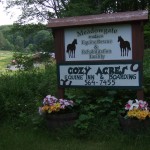
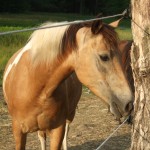
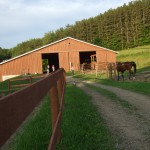
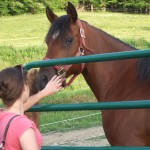
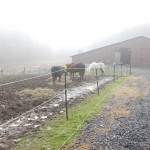
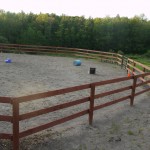

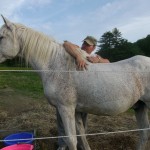
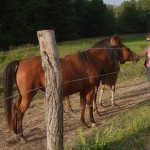
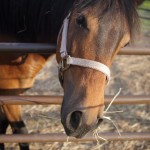
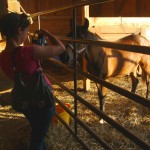
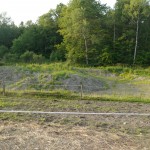
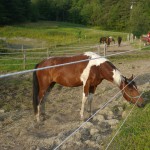
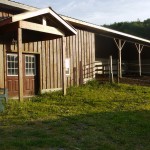
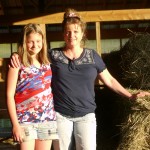
What a commendable task you people are doing to save these poor creatures. We are also engaged in these sort of activities to help those abandoned creatures.
Our mission is to rescue and rehabilitate animals, particularly horses, that have been injured, abused, neglected, abandoned or orphaned. We carry out this mission by providing good nutrition, medical care and emotional support in a safe and nurturing environment.
It takes a lot of time, work and financial resources to operate any type of rescue. Animals that find their way to your door often need a lot in the way of physical care, emotional support and medical treatment. They also need shelter and room to exercise. Shelters and exercise areas need to be erected and maintained.
Ways you can help include:
• Donate funds for veterinary and blacksmith care, rehabilitation, maintaining and building housing and exercise areas.
• Donate feed, bedding, building materials.
• Donate time or labor to help with animal care and farm maintenace.
Together we can make big difference.
For more details on Help Save Horses
Thanks
Karla
How good that there are caring people who are ready to help. Really appreciate it. I can’t even imagine what kind of atrocities a human being is capable of. These four-legged creatures deserve only love — big love, not suffering. God bless you!
Thank you Helga – I agree, horses desire the best we can give.